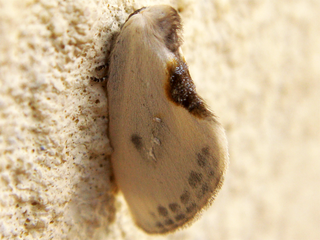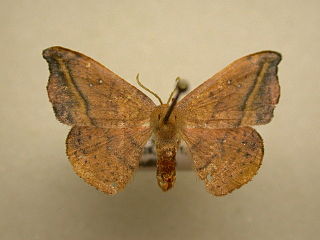
Drepaninae are by far the largest subfamily of the Drepanidae moths. While it is usually split into two tribes, Drepanini and Oretini, its internal systematics and phylogeny are not well resolved.

Achlya flavicornis, the yellow horned, is a moth of the family Drepanidae. The species was first described by Carl Linnaeus in his 1758 10th edition of Systema Naturae. It is found from Europe to the eastern Palearctic ecozone.

Cilix glaucata, the Chinese character, is a moth of the family Drepanidae. It was first described by the Italian physician and naturalist, Giovanni Antonio Scopoli in his 1763 Entomologia Carniolica. It is found in Europe, Asia Minor and North Africa.

Sabra harpagula, the scarce hook-tip, is a moth of the family Drepanidae first described by Eugenius Johann Christoph Esper in 1786. It is found from Europe through temperate Asia to Japan.

Tetheella is a monotypic moth genus in the family Drepanidae described by Werny in 1966. Its single species, Tetheella fluctuosa, the satin lutestring, was described by Jacob Hübner in 1803. It is found from western Europe across the Palearctic to Kamchatka, Sakhalin Island, Korea and Japan.

Nycteola asiatica, the eastern nycteoline, is a moth of the family Nolidae. The species was first described by Leonid Konstantinovich Krulikovsky in 1904. It is found in most of Europe and east across the Palearctic to Japan.

Gagitodes sagittata, the marsh carpet, is a moth of the family Geometridae. The species was first described by Johan Christian Fabricius in 1787. It is found in eastern Asia, including Japan, Korea and China and in central and northern Europe. It is sometimes included in the genus Perizoma

Cilix is a genus of moths belonging to the subfamily Drepaninae. The genus was erected by Leach in 1815.

Omphalophana antirrhinii is a moth of the family Noctuidae. It is found from southern France through all southern Europe, Corsica, Sardinia towards northern Iraq, western Iran, Jordan and Israel.

Epirrhoe galiata, the galium carpet, is a moth of the family Geometridae.

Tethea consimilis is a species of moth of the family Drepanidae first described by Warren in 1912. It is found in Asia, including the Russian Far East, Japan, Korea, Taiwan, Myanmar, Indonesia and India. The habitat consists of various types of mixed and broad-leaved forests.

Lymantria dispar asiatica, the LDA moth or Asian spongy moth, also known as the Asian gypsy moth, is a moth in the family Erebidae of Eurasian origin. It is similar to Lymantria dispar dispar in appearance, but adult females can fly. It is classified as a pest and is host to over 500 species of trees, shrubs and plants.
Cilix depalpata is a moth in the family Drepanidae first described by Strand in 1911. It is found in Afghanistan and Pakistan.

Cilix hispanica is a moth in the family Drepanidae. It is found in Portugal, Spain, southern France, Italy and North Africa.
Cilix algirica is a moth in the family Drepanidae described by Patrice J.A. Leraut in 2006. It is found in Morocco, Algeria and possibly Portugal.
Polyploca laororshanae is a moth in the family Drepanidae. The habitat of P. laororshanae is located in northern Israel and possibly Lebanon and Syria, although this remains unclear. The habitat consists of clearings and the fringes of evergreen sclerophyllous maquis on limestone.

Oreta rosea, the rose hooktip moth, is a moth in the family Drepanidae. It was described by Francis Walker in 1855. It is found in North America, where it has been recorded across boreal Canada to eastern North America. In the north, the range extends to northern Alberta, northern Manitoba and Newfoundland. It is also found east of the Great Plains as far south as Florida and eastern Texas. The habitat consists of moist temperate hardwood forests.
Cilix danieli is a moth in the family Drepanidae first described by Watson in 1968. It is found in Shanxi, China.
Cilix tatsienluica is a moth in the family Drepanidae first described by Oberthür in 1916. It is found in China.
Cilix argenta is a moth in the family Drepanidae. It is found in China.














